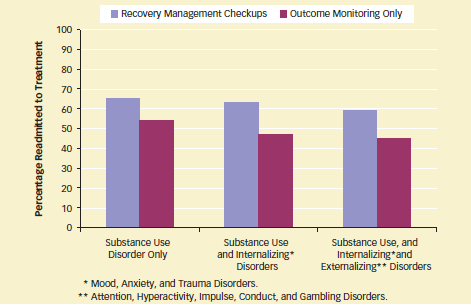A posttreatment intervention to support recovery may be especially beneficial for substance abusers with co-occurring mental disorders. In a recent subgroup analysis of data from previous trials, Dr. Michael Dennis and Dr. Christy Scott of Chestnut Health Systems in Chicago and Dr. Brian Rush of the Centre for Addiction and Mental Health in Toronto, Canada, found that clients with co-occurring disorders responded to the intervention with improvements on more measures than did substance abusers without other mental health problems.
 Recovery Management Checkup System Benefits Substance Abusers With Mental Disorders: More patients who participated in quarterly Recovery Management Checkups returned to treatment upon relapse than those who received assessments only. The enhanced-checkup intervention benefited substance abusers whether or not they had mental disorders.
Recovery Management Checkup System Benefits Substance Abusers With Mental Disorders: More patients who participated in quarterly Recovery Management Checkups returned to treatment upon relapse than those who received assessments only. The enhanced-checkup intervention benefited substance abusers whether or not they had mental disorders.Recovery management checkups (RMC) aim to identify and alleviate client problems before they derail recovery and to facilitate rapid readmission to treatment when recovery falters. Quarterly appointments form the core of RMC. During these sessions, interviewers assess clients using the structured Global Appraisal of Individual Needs tool and refer those with significant problems to a linkage manager, who administers a brief intervention using motivational interviewing techniques. The linkage manager connects clients who are willing to appropriate community resources, including admission to a treatment program, and continues to work with them until they have been engaged in treatment for at least 2 weeks. The conceptual framework of RMC is to treat addiction as a chronic disease, with long-term management to minimize the number of acute episodes of substance abuse and with prompt treatment when episodes occur to prevent them from becoming more severe and consequential.
The new analysis included 865 people who were recruited as they entered substance abuse treatment at the Haymarket Center in Chicago. Over 66 percent of the participants met past-year criteria for one or more co-occurring mental disorders, including 27 percent with only internalizing disorders (e.g., mood, anxiety, and trauma disorders) and 39 percent with both internalizing and externalizing disorders (e.g., attention, hyperactivity, impulse, conduct, and gambling disorders). Among the three groups, the likelihood of having a history of substance abuse treatment, of mental health treatment, and of a wide range of other problems, such as homelessness and victimization, was lowest in the participants with substance use disorder only and highest in those with substance abuse and both internalizing and externalizing mental disorders. In the latter group, 76 percent of the participants reported having been homeless at some time, and 91 percent reported having been victimized.
The study protocol assigned the participants to receive intensive outpatient therapy, short- or long-term residential therapy, or detoxification, as deemed appropriate based on their initial presentation. The study protocol scheduled all participants for quarterly visits to a clinic, beginning 90 days after their pretreatment interview and assessment and continuing for 2 years. Patients randomized to RMC received support from the linkage manager if they needed treatment, while patients randomized to control were only assessed, although they could re-enter treatment on their own.
Among all three comorbidity subgroups—those with only substance abuse, those with substance abuse and at least one internalizing disorder, and those with substance abuse and internalizing and externalizing disorders—more than 80 percent were assessed as needing to return to treatment at least once over the 2-year study. Consistent with the goals of RMC, more participants who received the intervention returned to treatment, and they returned sooner. Overall, 59 percent of the RMC group returned to treatment, as compared with 45 percent of the other group, and their average time before treatment was 306 days, as compared with 630 days. The sizes of these differences were similar across all the comorbidity subgroups.
On some additional outcomes, only RMC recipients with mental disorders showed a benefit. For example, RMC recipients with an internalizing disorder spent at least 40 more days in treatment than controls with those problems. Among patients with both an internalizing and an externalizing disorder, those who received RMC were abstinent on 51 more days than controls during the study and demonstrated an unmet need for treatment at nearly one-third fewer of their visits.
Concrete Long-Term Support
For most substance abusers—and especially those with co-occurring mental health problems—addiction is a chronic, relapsing condition. "Our recovery management checkup system addresses that reality, and it's good to see that the intervention helps an important subgroup of patients—those with co-occurring mental disorders—as well as others," Dr. Dennis says.
"Decisionmakers need data to convince them that RMC can work with patients who have the most severe problems, and our findings are a good first step in that direction," adds Dr. Rush. The researchers plan to verify their results by following part of the cohort for an additional 2 years. The Chestnut team also plans to test RMC with women leaving the criminal justice system in Chicago, and Dr. Rush has proposed developing an RMC system in Canada.
"The RMC intervention offers a recovery-oriented approach," says Dr. Thomas Hilton of NIDA's Division of Epidemiology, Services and Prevention Research. "It not only monitors substance abuse after treatment but also assesses the characteristics, or recovery capital, that facilitate a healthy, productive, drug-free lifestyle in the long term. Knowing each patient's recovery capital is critical because recovery occurs outside the direct care system and rests heavily on the shoulders of the individual. It makes good clinical sense to build up the patient's capacity for recovery if it is low, and the RMC offers a concrete intervention that provides support."
Source
Rush, B.R. et al. The interaction of co-occurring mental disorders and recovery management checkups on substance abuse treatment participation and recovery. Evaluation Review 32(1): 7-38, 2008. [Abstract]